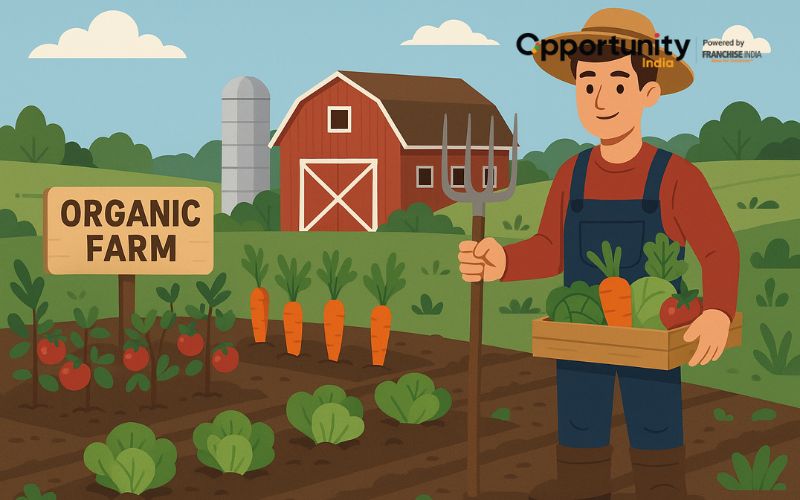
Imagine owning a land where you grow all your favourite vegetables, and you get to sell them. Organic farming, in particular, can be one of the most rewarding and successful endeavors you will ever engage in. You're in the perfect place if you've considered transforming that piece of land—or even a fresh farm concept—into a profitable, environmentally responsible enterprise. We will cover every step of establishing your organic farm in this guide, including how to turn a profit and what kind of initial investment is required.
Why Organic Farming? The Business Plan
Organic farming is a movement that aims to improve food systems, sustain agriculture, and the environment. It is more than just a passing trend. For ambitious farmers and business owners, organic farming is turning into a profitable business prospect due to growing consumer awareness and demand for produce free of chemicals.
Organic vegetables are in high demand due to health-conscious households and farm-to-table restaurants. Not only is this beneficial to the environment, but it is also a very fruitful basis for a successful business. It is a revolution in a world where people are becoming more aware of sustainability, health, and the effects on the environment.
Also Read: Aloe Vera Farming in India: A Business Plan
The appeal of organic farming goes beyond its morality. The market for organic items is strong and steadily expanding, and they frequently command higher prices than those grown traditionally. When food is guaranteed to be chemical-free, nutrient-dense, and produced with ecological integrity, consumers are ready to pay more for it. Your farm's potential for increased revenue is directly impacted by this.
Additionally, using organic farming methods frequently results in better soil, lower input costs over time (less need for artificial pesticides and fertilizers), and a more robust farm ecology. It's a long-term investment in the environment and your business.
Step-by-Step Guide to Start Organic Farming
If you are planning to enter this business, here’s a detailed guide:
What are your goals in the business?
- Who are your clients? At farmers' markets, neighborhood eateries, supermarkets, or direct-to-consumer delivery services, are you aiming to reach specific customers?
- What do they require? Research local demand for specific organic produce. Does your neighborhood have an inadequate supply of organic fruits or vegetables? Think of specialist crops that fetch higher prices, such as heritage kinds, specialty herbs, or unusual berry varieties.
- Analyzing competitors: Discover which organic farms are currently operating in your area. What do they cultivate? How do they advertise their goods? Which gaps are you able to fill?
- Certifications: Recognize your nation's organic certification procedure. For premium pricing and market legitimacy, this is an essential step.
What is your business plan?
A strong business plan cannot be compromised. It will act as a roadmap for you and be crucial if you want to apply for funding. Important elements consist of:
- Executive Summary: A concise synopsis of your whole strategy.
- Company Overview: The goals, objectives, and legal framework of your farm (sole proprietorship, partnership, LLC, etc.).
- Services and Goods: What you will grow, how you will grow it organically, and any goods with added value (such as organic pickles or jams).
- Market Analysis: The conclusions drawn from your studies on competitors, target consumers, and demand.
- Marketing and Sales Strategy: How you will market your product and connect with consumers.
- Operational Plan: Supply chain, personnel, equipment, and daily farming tasks.
- Management Team: The people and skills who will oversee the farm.
- Financial Projections: The core of your strategy, these estimates provide specifics on investment, revenue, expenses, and profitability.
Also Read: How To Start a Fish Farming Business With a Plan in India?
Land Acquisition & Assessment
- Location: It's important to be close to labor, marketplaces, and water sources.
- Consider Land History: To make organic certification simpler, steer clear of areas that have been poisoned with persistent chemicals.
- Soil Testing: Understanding pH levels, nutritional shortages, and soil health all depend on soil testing. This will direct your approach to adding organic soil amendments.
- Water Source: Having enough and dependable water is essential. Check the quality of the water if it comes from ponds or wells.
- Size: If you're new, start small. A few acres can yield a lot of fruit and be easy to manage. You can always grow.

Organic Certification Process
This process takes several years; on land that was previously farmed traditionally, the "transition" usually takes two to three years. You must follow organic guidelines during this time, but you are not yet allowed to sell your produce as "certified organic."
- Investigate Certification Organizations: Locate recognized certifiers in your area.
- Recognize Standards: Learn the specific regulations about record-keeping, crop rotation, buffer zones, pest control, soil fertility, and prohibited substances.
- Record Keeping: From the very beginning of your organic shift, meticulous documentation is crucial.
Implementation - Bringing Your Farm to Life
- Composting: Utilize food scraps, animal dung, and farm waste to create your compost.
- Cover Cropping: Planting cover crops, such as legumes or grasses, can enhance soil structure, increase nitrogen, restrict weed growth, and stop erosion.
- Crop Rotation: Switch up your crop family to disrupt pest and disease cycles and maintain nutrient uptake balance.
- Green Manure: To improve the soil, plow under young, succulent seeds.
- Organic Amendments: To supply the required nutrients, use seaweed extracts, rock dust, bone meal, and other natural inputs.
Plant & Seed Sourcing
- Organic Certified Seeds/Seedlings: Obtaining organic certification requires this. Non-GMO, untreated seeds with the appropriate paperwork are the best substitute if they are not accessible.
- Diversity: To reduce risks (disease, pests, and market swings) and to encourage biodiversity, grow a range of crops.
Pest, Disease & Weed Management
Don't use artificial sprays. An alternative strategy is needed for organic solutions:
- Neem oil sprays
- Cow urine mixtures
- Traps and barriers
- Companion planting (e.g., marigold with tomato)
Also Read: How To Set Up an AgriTech Business?
For weeds:
- Manual weeding
- Mulching
- Cover cropping
- Water Management
- Efficient Irrigation: Water waste is decreased, and fungal diseases are avoided with drip irrigation and soaker hoses.
- Rainwater Harvesting: Think about rainwater collection and storage methods.

Equipment & Infrastructure
- Essential Tools: Wheelbarrows, shovels, hoes, and hand tools.
- Tillage Tools: A power tiller or a small tractor with tools, depending on your scale.
- Irrigation System: drip lines, pipes, and pumps.
- Storage: Tool sheds, a space for packaging, and possibly a cold storage unit.
- Fencing: To keep animals away from crops.
- Greenhouse/Polyhouse: For growing specialist crops, prolonging growing seasons, or starting seedlings.
Marketing & Sales - Reaching Your Customers
- Unique Selling Proposition (USP): What is unique about your farm? Is it a particular passion, sustainable practices, community involvement, or your own special varieties?
- Share Your Story: Customers wish to establish a relationship with their food source. Talk about your values, your journey, and your dedication to organic principles. Make use of your website, social media, and face-to-face communication.
Target markets:
- Local organic stores
- Farmers’ markets
- Online platforms (BigBasket, Amazon Pantry)
- Subscription models (weekly delivery of organic kits)
- Direct to consumers (farm visits, WhatsApp orders)
Also Read: How To Get FSSAI License For a Home Kitchen Business?
Investment: How Much Does It Cost?
| Expense | Cost (Approx.) |
|---|---|
| Land lease (1 year) | ₹30,000 – ₹50,000 |
| Soil testing | ₹2,000 |
| Organic inputs (seeds, compost, natural sprays) | ₹20,000 |
| Drip irrigation setup | ₹25,000 – ₹40,000 |
| Fencing | ₹15,000 |
| Certification (PGS/NPOP) | ₹10,000 – ₹30,000 |
| Basic tools & shed | ₹10,000 |
| Labour (seasonal) | ₹30,000 |
| Total | ₹1.5 – ₹2.5 Lakhs |
Key to Profitability:
- Choosing High-Value Crops: Pay attention to what sells and is priced competitively.
- Direct Marketing: To obtain the entire retail value, increase sales through direct-to-consumer channels, farmers' markets, and CSAs.
- Efficient Operations: Reduce waste, maximize labor, and make wise use of resources.
- Diversification: Plant a range of crops to spread out risk and provide steady revenue.
- Value-Added Products: Turn extra food into sauces, jams, or dried goods to extend their shelf life and boost sales.
Organic farming is a dedication to healthier food, healthier people, and a healthy planet, and it goes beyond simply being a business. Although it requires commitment, expertise, and a one-time expense, the financial and tangible advantages are significant. You can grow nutritious food, save the environment, and create a reliable source of income with a small amount of land, some natural inputs, and a lot of enthusiasm.

